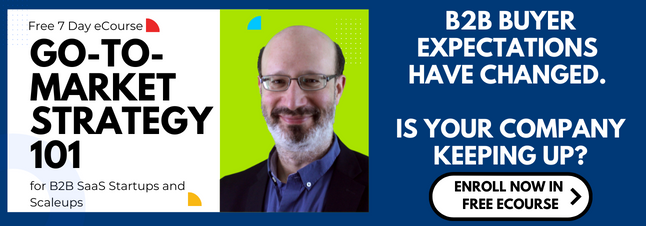Many tech startups lack the go-to-market strategy and resources to compete successfully and win deals in the digital buyer’s journey. Here’s how to tell if your startup is in the same boat and, if so, how your tech startup can effectively compete for new customers in the digital buyer’s journey.
In this video, you’ll learn why tech startups need a new go-to-market strategy for competing and winning new customers in the digital buyer’s journey, how to approach this paradigm shift with the right mindset and resources, and what realistically resourcing looks like.
B2B buyers no longer research, compare options, and make purchase decisions like they did just a few short years ago.
The latest research from Gartner found that 83% of a typical B2B purchase decision -- researching, comparing options, and evaluating pricing -- happens before a potential buyer engages with a vendor.
And McKinsey & Company has discovered that 70% to 80% of B2B decision-makers now prefer to make decisions digitally.
In its B2B Thought Leadership Impact Report, LinkedIn, in partnership with Edelman, concluded that “thought leadership remains critical to customer engagement but breaking through the noise is harder than ever.”
How do you break through the noise?
Tech startups need to know their ideal customers better than their ideal customers know themselves.
As a way of analyzing and documenting commonalities, buyer personas are semi-fictional representations of your ideal customers based on actual research and some select, educated speculation.
Buyer personas are essential to engaging potential customers and breaking through the noise.
To see this in practice, let’s meet an ideal buyer persona and a salesperson that desperately wants to get that buyer persona onto their deals board in their CRM:

Computer Support Carolyn
Computer Support Carolyn is a woman in her mid-’30s. She’s married with two school-aged children and has worked at this company for five years.
Computer Support Carolyn is struggling to find software that helps her company’s finance team support its growing international client base.
Computer Support Carolyn looks for possible solutions on Google, LinkedIn, and YouTube. And she enjoys learning about doing her job better by attending webinars with thought leaders in her industry.
Account Executive Alan
Account Executive Alan is a man in his mid-’50s. He’s married with three grown children and has worked at this company for twenty years.
Account Executive Alan struggles to connect with leads through cold calls, cold emails, and cold LinkedIn connections.

Computer Support Carolyn’s company is on Account Executive Alan’s target account list. And Computer Support Carolyn is likely a critical stakeholder in the decision-making process.
Navigating the digital buyer’s journey
So let’s watch over the shoulder of Computer Support Carolyn to observe how she’s navigating the digital buyer’s journey.
While sitting at her desk, Computer Support Carolyn types in a Google search for “best financial software for growing internationally.”
She clicks on the first search engine result, reads a blog post, and notices that there’s a related free eBook available for download.

Computer Support Carolyn fills out the form to download the free eBook. Then she posts a message on LinkedIn (on her profile): “I’m looking into financial software for growing internationally.”
A few minutes later, a colleague she’s known for years (CFO Kate) comments on the LinkedIn post, mentioning a specific company and software application and linking to that company’s YouTube channel.
Go Away, Alan!
While Computer Support Carolyn’s still sitting at her desk, she sees her phone ringing with a call from Account Executive Alan on her caller ID…again! His fourth call this month! Carolyn rolls her eyes and lets the call go to voicemail.

Later that day, Computer Support Carolyn visits her colleague’s recommended YouTube channel for the financial software vendor, watches a few videos, notices that the company is hosting a related webinar next Wednesday, and registers for the webinar.
Computer Support Carolyn then checks her email inbox to ensure the webinar registration confirmation email arrived -- which it did and adds the webinar to her calendar.
Take a Hint, Alan!
Meanwhile, Computer Support Carolyn also noticed an email from Account Executive Alan, his fourth email this month. She again ignores and remarks to herself, “Wow, Alan! Can’t you take a hint?!? I can get all the information I need from Google, LinkedIn, YouTube, and webinars. I do not need to talk with you, at least not now.”
Frustrated Alan
Sitting at his desk, Account Executive Alan is incredibly frustrated and remarks to himself, “I left 43 voicemails today and sent 117 customized email messages. And not a single response. What the heck is going on?”
Account Executive Alan faceplants the palm of his hand on his forehead as he reads his LinkedIn feed, “The latest research from Gartner found that 83% of a typical B2B purchase decision -- researching, comparing options, and evaluating pricing -- happens before a potential buyer engages with a vendor.”

Tomorrow, Account Executive Alan notices a LinkedIn post from McKinsey & Company: “70% to 80% of B2B decision-makers now prefer to make decisions digitally.”
How to compete and win in the digital buyer’s journey
Shortly after that, Account Executive Alan runs his own Google search, “how can salespeople use LinkedIn to get in front of potential customers?”
After reading a few blog posts and watching a few related YouTube videos on this same topic, Account Executive Alan concludes that his employer isn’t making the necessary investments to compete and win in the digital buyer’s journey.
And if you’re serious about How Tech Startups Compete in the Digital Buyer’s Journey...
Learn more when you enroll now in our free 7-day eCourse: Go-to-Market Strategy 101 for B2B SaaS Startups and Scaleups.



Submit a comment